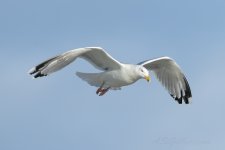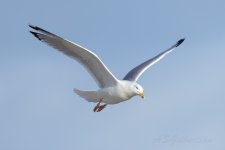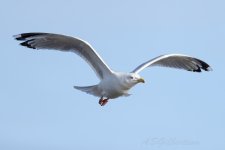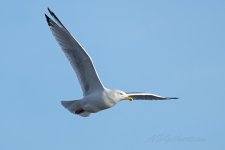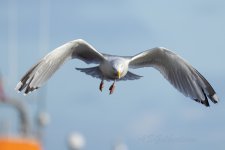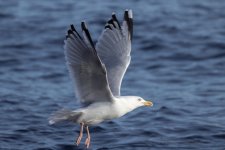Barred Wobbler
Well-known member
Sadly, I'm not the greatest gull fan. I'm not into the multitude of intricacies of ageing and allocation to subspecies in common, I suspect, with many more. To my shame, beyond telling which species they are, I tend to categorise them as 'grown up' 'just a child' and 'not grown up yet'.
I was at North Shields a couple of times this week, giving a new lens a trial run. On Tuesday I was with a friend who, unlike me, does know his gulls. He loves them. That evening, when going through his shots, he noticed a gull where the white/grey of the outer primaries extended well into the black tips, and he wondered if it might be a Scandinavian 'argentatus'. I was going back yesterday, so I decided to look out for it. In the meantime, he had posted his photos onto a gull fans' website, and someone had suggested it might be an American Herring Gull. I appreciate that Collins says than in many cases an adult American can be almost inseparable, but given the wing tip variation (and my ignorance), does this mean inseparable from argenteus, or inseparable from argentatus?
These are some of the shots I got of the same bird yesterday, when it turned up mid-afternoon for fishing boat scraps. I suspect it had followed two boats that had just come in from sea, because I'd not seen it in the few hours I'd been there until I got these pics.
Any gull experts care to comment?
I was at North Shields a couple of times this week, giving a new lens a trial run. On Tuesday I was with a friend who, unlike me, does know his gulls. He loves them. That evening, when going through his shots, he noticed a gull where the white/grey of the outer primaries extended well into the black tips, and he wondered if it might be a Scandinavian 'argentatus'. I was going back yesterday, so I decided to look out for it. In the meantime, he had posted his photos onto a gull fans' website, and someone had suggested it might be an American Herring Gull. I appreciate that Collins says than in many cases an adult American can be almost inseparable, but given the wing tip variation (and my ignorance), does this mean inseparable from argenteus, or inseparable from argentatus?
These are some of the shots I got of the same bird yesterday, when it turned up mid-afternoon for fishing boat scraps. I suspect it had followed two boats that had just come in from sea, because I'd not seen it in the few hours I'd been there until I got these pics.
Any gull experts care to comment?
Attachments
Last edited:




